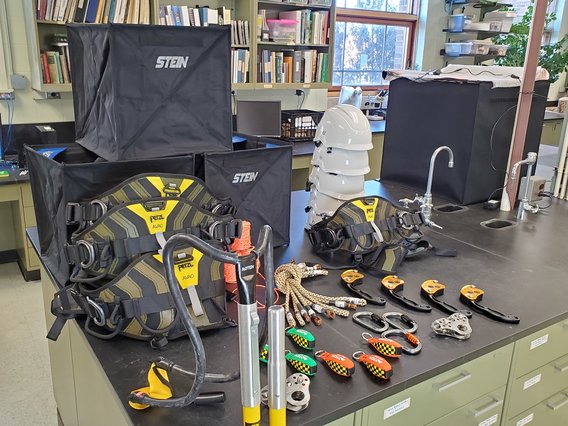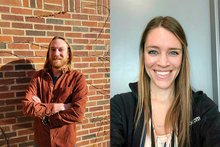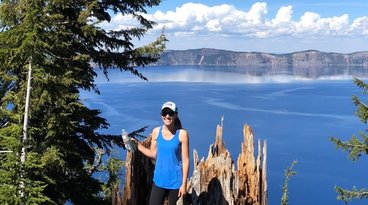Bartlett Tree Experts and The Davey Tree Expert Company generously donated thousands of dollars worth of climbing gear for our students. Davey Tree also awarded $1,000 Arbor Grant Scholarships to Margaret Beadle and Hank Dudley—undergraduate students on the Urban and Community Forestry track in the Forest and Natural Resource Management major. We are so grateful for the support our community partners provide to help our students succeed in their present education and their future careers. We asked Hank and Margaret some questions about their past, present, and future in forestry, and here's what they had to say.


Where are you from?
Margaret Beadle: "I'm from Mahtomedi, MN."
Hank Dudley: "I grew up in Cold Spring, MN near Saint Cloud, but have lived in the Twin Cities for nearly 10 years."
What interests you about forestry?
HD: "The topics I find most interesting largely pertain to disciplines that will be most applicable in my career as an urban forester. Things like arboriculture, plant identification classes, and the art and design classes. I also really enjoy plant physiology and propagation classes."
MB: "Each semester continues to introduce me to something new and exciting that sparks my interest. The most interesting topic of study would have to be anything related to tree care in urban environments. Last summer (2021) I was able to work for the city of St. Paul as an urban forestry intern. It was here where I learned how valuable urban forests are to communities and how they substantially impact the health and wellness of municipalities."
Why did you decide to study forestry at the University?
MB: "I initially chose forestry because I grew up hiking, exploring, and camping in some of Minnesota’s most beautiful state parks and forests. My love for nature turned into a passion and I knew the University of Minnesota was where I wanted to further pursue my education in this field."
HD: "I decided to pursue forestry at the U after taking a class on the Saint Paul campus and having a discussion with a friend who was studying there at the time. Compared to my previous experience in the College of Liberal Arts, the culture and atmosphere in the natural resource sciences felt like a much better fit for me. Forestry feels like something I can excel at as well as make an impact on my community."
What do you hope to achieve in forestry?
MB: "My goal for the future is to be able to help these municipalities further their goals and practices to preserve the health and sustainability of urban forests and their surrounding environments."
HD: "My goals with urban forestry are to improve the communities I work in and to forge meaningful relationships with the people I work with and serve. I have been interested in attaining a municipal forestry position in the Twin Cities metro area since deciding to study urban forestry; however, I feel that whatever direction my career takes me, municipal or commercial, I will be able to improve the community I work in and make a difference in the world. One goal that helps me stay motivated throughout the semesters is that I hope to plant a tree one day and return many years later to see that tree fully mature and be enjoyed by the people in the community. I believe what I have learned, am learning, and will continue to learn about the science of forestry will serve me well throughout my life. I plan to not only build a career in forestry, but also to implement what I have learned into my personal life as well. As a person who hopes to one day own some property, I plan on using the knowledge I have gained about forestry to properly manage the natural resources on my own property in an effective, sustainable, and responsible way."
What should more people understand about forestry?
HD: "I would say the most annoying thing about studying forestry is explaining what forestry is to everyone not in a natural resources field. It sometimes feels like no one knows what forestry is, that it even exists, or why it’s needed at all. I wish that more people understood the complex way that plants operate. I feel like many people take plants for granted. In an urban community, where a single tree can make a great deal of difference to a homeowner’s electricity bill, the city’s water storage infrastructure, and countless other benefits; a minor wound caused by improper pruning or negligent lawn maintenance can have a huge effect if left untreated. I feel that if more homeowners understood the way their trees and other green infrastructure operate, and the services they provide, they would be more keen on protecting this valuable resource that is fortunately so plentiful in the Twin Cities."
MB: "One thing I wish people understood more is that the discipline of forestry does not have one cut and dry answer to solving all forestry issues. Forestry in itself is complex, dynamic, and ever changing. New research is being done every day to improve on our knowledge and understanding forest impacts, our future predictions, and what strategies and goals work best towards creating healthier forests."
What would you change about forestry?
MB: "One thing I would like to see improved in urban forestry is diversity and inclusion. Diversity allows for creativity and inspiration and brings together different cultures and backgrounds to forge a commodity of fresh perspectives and new ideas. Collaboration among a community is a wonderful way to help people understand the importance of forest health and sustainability."
HD: "One major thing I would like to see in forestry is an increase in diversity. Although there are many initiatives dedicated to this already, I notice that many of my fellow students at the U are a very homogenous demographic. I think that introducing forestry concepts to a younger age group through school or extracurricular opportunities is one way that we can see diversity increase in the field of forestry."

Image 1 description: Tree climbing equipment laid out on a lab table. Equipment includes climbing harnesses, ropes, carabiners, and more.
Image 2 description: Side by side photo of Hank Dudley, a white man with long brown hair wearing a brown coat and smiling and standing in front of a brick wall, and Margaret Beadle, a white woman with long blonde hair smiling in a black coat against a grey background.
Image 3 description: Margaret Beadle, a white woman wearing a white hat, sunglasses, and a blue tank top, leaning against a large tree stump in an evergreen forest against a blue lake background.

The Forest Scene newsletter is published biannually in the spring and fall, featuring stories and updates from the Department of Forest Resources. Readers can download issue 26 of Forest Scene as an interactive PDF that is fully tagged and compatible with most screen readers, or read the individual stories here in a web-based format.
